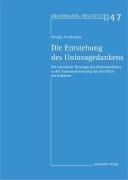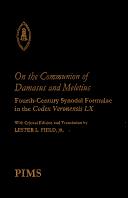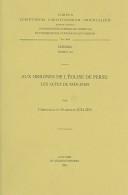| Listing 1 - 6 of 6 |
Sort by
|
Book
ISBN: 1782041761 1843838656 Year: 2013 Publisher: Woodbridge, Suffolk : Boydell Press,
Abstract | Keywords | Export | Availability | Bookmark
 Loading...
Loading...Choose an application
- Reference Manager
- EndNote
- RefWorks (Direct export to RefWorks)
In the first millennium the Christian Church forbade its clergy from bearing arms. In the mid-eleventh century the ban was reiterated many times at the highest levels: all participants in the battle of Hastings, for example, who had drawn blood were required to do public penance. Yet over the next two hundred years the canon law of the Latin Church changed significantly: the pope and bishops came to authorize and direct wars; military-religious orders, beginning with the Templars, emerged to defend the faithful and the Faith; and individual clerics were allowed to bear arms for defensive purposes. This study examines how these changes developed, ranging widely across Europe and taking the story right up to the present day; it also considers the reasons why the original prohibition has never been restored. Lawrence G. Duggan is Professor of History at the University of Delaware and research fellow of the Alexander von Humboldt Foundation.
Clergy (Canon law) --- Priests (Canon law) --- Catholic Church --- War --- History --- Religious aspects --- Catholic church --- History of doctrines --- Armed conflict (War) --- Conflict, Armed (War) --- Fighting --- Hostilities --- Wars --- International relations --- Military art and science --- Church history --- Christianity --- Middle Ages, 600-1500 --- Aural and visual experience. --- Bishops. --- Canon law. --- Clergy. --- Crusading. --- Latin Church. --- Lawrence G. Duggan. --- Military-religious orders. --- Pope. --- Religious practices. --- Self-flagellation. --- Warfare. --- Western Christianity. --- battles. --- canon law. --- conflict. --- history. --- medieval church. --- military-religious orders. --- religious history. --- warfare.

ISBN: 3050037156 3050050071 Year: 2002 Volume: n.F., 47. Publisher: Berlin : Akademie Verlag,
Abstract | Keywords | Export | Availability | Bookmark
 Loading...
Loading...Choose an application
- Reference Manager
- EndNote
- RefWorks (Direct export to RefWorks)
Una fide, diverso ritu - "Im einen Glauben, in der Verschiedenheit der Riten": Mit dieser im 12. Jahrhundert geprägten Formel wurde seit dem Mittelalter bis in die Frühe Neuzeit immer wieder versucht, in Form von "Kirchenunionen" das Schisma zwischen dem lateinischen und dem byzantinischen Christentum zu heilen. Man bemühte sich, die gegenseitige Intoleranz dadurch zu überwinden, daß man sich bereit erklärte, unterschiedliche rituelle und disziplinäre Kulturformen im Rahmen der einen, vom römischen Papst geleiteten und in der Einheit des Glaubens stehenden Kirche zuzulassen und anzuerkennen. Der Unionsgedanke stellt somit einen der frühesten Versuche des westlichen Denkens dar, sich mit den Fragen der christlichen Einheit auseinanderzusetzen. Der Unionsgedanke bildete sich heraus als Bewältigung jener Herausforderung, die die Eigenart der Ostkirche und die damit verbundenen Konflikte und Polemiken hervorgerufen haben. Die Fragen des Ritenvollzugs der Sakramente spielten dabei die Schlüsselrolle. Es zeigt sich im Laufe der Untersuchung, daß sich die gesamten kirchenpolitischen und theologischen Beziehungen zwischen Ost und West im Hochmittelalter in gewisser Hinsicht stets um die Streitfragen des Ritus drehten. In den verwickelten Nuancen der diesbezüglichen theologischen Kontroversen verbirgt sich eine scharfsinnige Auseinandersetzung um grundlegende Fragen der interkulturellen Kommunikation. Aus dem Inhalt: 1. Teil Die ostkirchliche Herausforderung: Konflikte und Polemiken um die Fragen des Ritus A. Der Azymenstreit B. Das Problem der Wasserbeimischung C. Der Taufformelstreit 2. Teil Die lateinischen Zugänge zur Eigenart der Ostkirche: Im Spannungsfeld zwischen "Zurückführung" und Union D. Die politische Dimension E. Die Reflexion der Lateiner.
Schism --- Christian union. --- Schisme d'Orient --- Oecuménisme --- Eastern and Western Church. --- Orthodox Eastern Church --- Catholic Church --- Eglise orthodoxe --- Eglise catholique --- Relations --- Catholic Church. --- Orthodox Eastern Church. --- 28*082.1 --- Oecumenische discussies tussen katholieken en orthodoxen --- 28*082.1 Oecumenische discussies tussen katholieken en orthodoxen --- Oecuménisme --- Christian union --- Eastern Schism --- Great Schism --- Greco-Roman Schism --- Catholicity --- Christianity --- Church unity (Ecumenism) --- Ecumenism --- Irenics --- Christian sects --- Church --- Ecumenical movement --- Eastern and Western Church --- Greek and Latin Church --- Latin and Greek Church --- Union between churches --- Church of Rome --- Roman Catholic Church --- Katholische Kirche --- Katolyt︠s︡ʹka t︠s︡erkva --- Römisch-Katholische Kirche --- Römische Kirche --- Ecclesia Catholica --- Eglise catholique-romaine --- Katolicheskai︠a︡ t︠s︡erkovʹ --- Chiesa cattolica --- Iglesia Católica --- Kościół Katolicki --- Katolicki Kościół --- Kościół Rzymskokatolicki --- Nihon Katorikku Kyōkai --- Katholikē Ekklēsia --- Gereja Katolik --- Kenesiyah ha-Ḳatolit --- Kanisa Katoliki --- כנסיה הקתולית --- כנסייה הקתולית --- 가톨릭교 --- 천주교

ISSN: 00825328 ISBN: 0888441452 9780888441454 Year: 2004 Volume: 145 Publisher: Toronto: Pontifical institute of mediaeval studies,
Abstract | Keywords | Export | Availability | Bookmark
 Loading...
Loading...Choose an application
- Reference Manager
- EndNote
- RefWorks (Direct export to RefWorks)
Church history --- Schism --- Eastern and Western Church --- Damasus, --- Bible. --- Codex veronensis LX --- 262.13 DAMASUS I --- 27 "03" --- Pausschap. Heilige Stoel. Vaticaan. Paus als soeverein--DAMASUS I --- Kerkgeschiedenis--?"03" --- 262.13 DAMASUS I Pausschap. Heilige Stoel. Vaticaan. Paus als soeverein--DAMASUS I --- Eastern Schism --- Great Schism --- Greco-Roman Schism --- Apostolic Church --- Christianity --- Church, Apostolic --- Early Christianity --- Early church --- Primitive and early church --- Primitive Christianity --- Fathers of the church --- Great Apostasy (Mormon doctrine) --- Greek and Latin Church --- Latin and Greek Church --- Damase --- Damaso --- Damasus --- Codex Veronensis LX. --- van Rijn, Gijsbert --- Church history - Primitive and early church, ca. 30-600 --- Schism - Eastern and Western Church --- Damasus I p. --- Meletius ep. Antiochenus --- Damasus, - I, - Pope, - 305-384

ISSN: 00700444 ISBN: 904290674X 2877233960 9789042906747 9782877233965 Year: 1999 Volume: 574 100 Publisher: Lovanii : Peeters,
Abstract | Keywords | Export | Availability | Bookmark
 Loading...
Loading...Choose an application
- Reference Manager
- EndNote
- RefWorks (Direct export to RefWorks)
Eglise catholique --- Fédération de Russie --- Histoire ecclésiastique --- Katholieke Kerk --- Kerkgeschiedenis --- Russische Federatie --- Armenian Church --- Schism, Acacian, 484-519 --- Eglise arménienne --- Schisme d'Acace, 484-519 --- History --- Histoire --- Oriental Orthodox churches --- Relations --- Orthodox Eastern Church --- 281.6 --- Academic collection --- Acacian Schism --- Greco-Roman Schism --- Schism --- Church history --- Monophysites --- Armeense Kerk --- Greek and Latin Church --- Latin and Greek Church --- Eastern and Western Church --- -Hayastaneaytsʻ S. Ekeghetsʻi --- Armenian Apostolic Orthodox Church --- Hay Aṛakʻelakan Ekeghetsʻi --- Eglise apostolique arménienne --- Hayotsʻ Ekeghetsʻi --- Hay Ekeghetsʻi --- Hayastaneaytsʻ Ekeghetsʻi --- Hayastaneaytsʻ Aṛakʻelakan Ekeghetsʻi --- Armenian Apostolic Church --- Armenische Kirche --- Biserica armeană --- Armenikē Ekklēsia --- Hayastaneaytsʻ Aṛakʻ. Surb Ekeghetsʻi --- Armi︠a︡nskai︠a︡ Apostolʹskai︠a︡ T︠S︡erkovʹ --- Églises orientales --- Hérésies chrétiennes --- Armeense Kerk. --- Schisme d'Orient. --- Morgenländisches Schisma --- Morgenländisches Schisma. --- Orthodox Eastern Church. --- Église arménienne --- Eglise apostolique arménienne --- Armenische Kirche. --- History. --- Oriental Orthodox Church. --- Armenia --- Georgia (Republic) --- Empire byzantin --- Arménie --- Church history. --- Histoire religieuse. --- -History --- 281.6 Armeense Kerk --- Histoire. --- Eglise arménienne --- Ancient Oriental churches --- Ante-Chalcedonian Orthodox churches --- Lesser Eastern Orthodox churches --- Orthodox Oriental churches --- Pre-Chalcedonian Orthodox churches --- Eastern churches --- Relations&delete& --- Hayastaneaytsʻ S. Ekeghetsʻi --- Hayasdan --- Hayastan --- Aĭastan --- Haykʻ Metskʻ --- Mets Haykʻ --- Greater Armenia --- Armenia (Republic) --- Армянская Апостольская Церковь --- Armenische Apostolische Kirche --- Oriental Orthodox churches - Relations - Orthodox Eastern Church
Book
ISBN: 0826273076 9780826273079 082622010X 9780826220103 9780826220103 Year: 2014 Publisher: Columbia, Missouri
Abstract | Keywords | Export | Availability | Bookmark
 Loading...
Loading...Choose an application
- Reference Manager
- EndNote
- RefWorks (Direct export to RefWorks)
Under the broad umbrella of the Christian religion, there exists a great divide between two fundamentally different ways of thinking about key aspects of the Christian faith. Eugene Webb explores the sources of that divide, looking at how the Eastern and Western Christian worlds drifted apart due both to the different ways they interpreted their symbols and to the different roles political power played in their histories. Previous studies have focused on historical events or on the history of theological ideas. In Search of the Triune God delves deeper by exploring how the Christian East and the Christian West have conceived the relation between symbol and experience. Webb demonstrates that whereas for Western Christianity discussion of the doctrine of the Trinity has tended toward speculation about the internal structure of the Godhead, in the Eastern tradition the symbolism of the Triune God has always been closely connected to religious experience. In their approaches to theology, Western Christianity has tended toward a speculative theology, and Eastern Christianity toward a mystical theology. This difference of focus has led to a large range of fundamental differences in many areas not only of theology but also of religious life. Webb traces the history of the pertinent symbols (God as Father, Son of God, Spirit of God, Messiah, King, etc.) from the Hebrew Bible and New Testament through patristic thinkers and the councils that eventually defined orthodoxy. In addition, he shows how the symbols, interpreted through the different cultural lenses of the East and the West, gradually took on meanings that became the material of very different worldviews, especially as the respective histories of the Eastern and Western Christian worlds led them into different kinds of entanglement with ambition and power. Through this incisive exploration, Webb offers a dramatic and provocative new picture of the history of Christianity.
Church history --- Schism --- God (Christianity) --- Trinity --- Eastern Schism --- Great Schism --- Greco-Roman Schism --- Christianity --- Eastern and Western Church. --- History of doctrines. --- History of doctrines --- Greek and Latin Church --- Latin and Greek Church --- Middle Ages, 600-1500 --- Orthodox Eastern Church --- Catholic Church --- Doctrines --- History. --- Relations --- Orthodox Eastern Church. --- Catholic Church. --- 231.01 --- 23 <09> --- 273 <09> --- 231.01 Drieëenheid. Drievuldigheid --- Drieëenheid. Drievuldigheid --- Dogmengeschichte. Geschiedenis van het dogma --- Schisma's. Ketterijen--Geschiedenis van .. --- Trinity. --- Theology, Doctrinal --- Triads (Philosophy) --- Appropriation (Christian theology) --- Godhead (Mormon theology) --- Holy Spirit --- Trinities --- Tritheism --- Schisma's. Ketterijen--Geschiedenis van . --- Church of Rome --- Roman Catholic Church --- Katholische Kirche --- Katolyt︠s︡ʹka t︠s︡erkva --- Römisch-Katholische Kirche --- Römische Kirche --- Ecclesia Catholica --- Eglise catholique --- Eglise catholique-romaine --- Katolicheskai︠a︡ t︠s︡erkovʹ --- Chiesa cattolica --- Iglesia Católica --- Kościół Katolicki --- Katolicki Kościół --- Kościół Rzymskokatolicki --- Nihon Katorikku Kyōkai --- Katholikē Ekklēsia --- Gereja Katolik --- Kenesiyah ha-Ḳatolit --- Kanisa Katoliki --- כנסיה הקתולית --- כנסייה הקתולית --- 가톨릭교 --- 천주교 --- Schisma's. Ketterijen--Geschiedenis van
Book

ISBN: 9781400861194 1400861195 0691631786 0691602255 Year: 2014 Publisher: Princeton, NJ
Abstract | Keywords | Export | Availability | Bookmark
 Loading...
Loading...Choose an application
- Reference Manager
- EndNote
- RefWorks (Direct export to RefWorks)
Covering Portugal and Castile in the West to the Latin Kingdom of Jerusalem in the East, this collection focuses on Muslim minorities living in Christian lands during the high Middle Ages, and examines to what extent notions of religious tolerance influenced Muslim-Christian relations. The authors call into question the applicability of modern ideas of toleration to medieval social relations, investigating the situation instead from the standpoint of human experience within the two religious cultures. Whereas this study offers no evidence of an evolution of coherent policy concerning treatment of minorities in these Christian domains, it does reveal how religious ideas and communitarian traditions worked together to blunt the harsh realities of the relations between victors and vanquished.The chapters in this volume include "The Mudejars of Castile and Portugal in the Twelfth and Thirteenth Centuries" by Joseph F. O'Callaghan, "Muslims in the Thirteenth-Century Realms of Aragon: Interactions and Reaction" by Robert I. Burns, S.J., "The End of Muslim Sicily" by David S. H. Abulafia, "The Subjected Muslims of the Frankish Levant" by Benjamin Z. Kedar, and "The Papacy and the Muslim Frontier" by James M. Powell.Originally published in 1990.The Princeton Legacy Library uses the latest print-on-demand technology to again make available previously out-of-print books from the distinguished backlist of Princeton University Press. These editions preserve the original texts of these important books while presenting them in durable paperback and hardcover editions. The goal of the Princeton Legacy Library is to vastly increase access to the rich scholarly heritage found in the thousands of books published by Princeton University Press since its founding in 1905.
Christianity and other religions --- Islam --- Muslims --- Mohammedans --- Moors (People) --- Moslems --- Muhammadans --- Musalmans --- Mussalmans --- Mussulmans --- Mussulmen --- Religious adherents --- Islam. --- Relations --- Christianity. --- History. --- Latin Orient. --- East, Latin --- Latin East --- Orient, Latin --- Islamic Empire --- Middle East --- Orient --- Latin Empire, 1204-1261 --- History --- 1st century. --- Abbasid Caliphate. --- Al-Andalus. --- Al-Maqrizi. --- Al-Mu'tamid. --- Alfonso VI. --- Alfonso X of Castile. --- Aljama. --- Almohad Caliphate. --- Amalric of Jerusalem. --- Arab culture. --- Arabic name. --- Arabic. --- Arabist. --- Battle of Muret. --- Bernard Crick. --- Caesarea. --- Caliphate of Córdoba. --- Canon law. --- Christian martyrs. --- Christian state. --- Church History (Eusebius). --- Conquest of Majorca. --- Constantine the Great. --- Continental Europe. --- Early Muslim conquests. --- Emirate of Granada. --- Eritrea. --- Fatimid Caliphate. --- Freeman (Colonial). --- Friar. --- Guido delle Colonne. --- Hanbali. --- Hebrew University of Jerusalem. --- Henricus. --- High Middle Ages. --- Hugh of Cluny. --- Iberian Peninsula. --- Ibn Arabi. --- Ibn Hud. --- Ibn Jubayr. --- Ibn Sab'in. --- International Institute of Islamic Thought. --- Islam and the West. --- Islam by country. --- Islam in Spain. --- Islamic culture. --- Islamic revival. --- Islamism. --- Judea (Roman province). --- Kingdom of Seville. --- Knights Hospitaller. --- Late Middle Ages. --- Latifundium. --- Latin Church. --- Latin Rule. --- Latin alphabet. --- Latins (Italic tribe). --- Lucera. --- Maarrat al-Nu'man. --- Modern Standard Arabic. --- Mongols. --- Moors. --- Mozarabs. --- Mudéjar. --- Muslim Brotherhood. --- Muslim world. --- Muslim. --- Muslims (nationality). --- Musulman. --- Names of God in Islam. --- New Latin. --- Oriental Orthodoxy. --- Peter the Venerable. --- Pope Boniface VIII. --- Pope Gelasius I. --- Pope Gregory IX. --- Pope Gregory VII. --- Pope Gregory VIII. --- Pope Paschal II. --- Pope Urban II. --- Pope. --- Primate (bishop). --- Principality of Antioch. --- Quran. --- Reconquista. --- Religion. --- Roman Rite. --- Sasanian Empire. --- Sicilia (Roman province). --- Sufism. --- Sunni Islam. --- Syria Palaestina. --- Templar of Tyre. --- Universal jurisdiction. --- Visigothic Code. --- Western Christianity. --- Westernization.
| Listing 1 - 6 of 6 |
Sort by
|

 Search
Search Feedback
Feedback About UniCat
About UniCat  Help
Help News
News